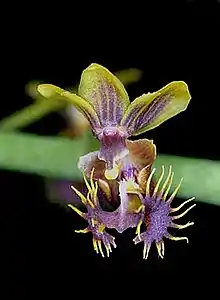Phalaenopsis difformis
Phalaenopsis difformis, also known as the dark brown Phalaenopsis, is a species of epiphytic orchid native to Assam, Borneo, China South-Central, China Southeast, East Himalaya, Laos, Malaya, Myanmar, Bangladesh, Nepal, Sumatera, Thailand, Vietnam and West Himalaya.[13] This species has a complex taxonomic history and has been previously assigned to several genera. The extensive list of synonyms may be explained by this species wide distribution. Within this species two variations, Phalaenopsis difformis var. difformis and Phalaenopsis difformis var. kinabaluensis (J.J.Wood, A.L.Lamb & Shim) Kocyan & Schuit., are formally recognized.
| Phalaenopsis difformis | |
|---|---|
 | |
| Flower detail | |
| Scientific classification | |
| Kingdom: | Plantae |
| Clade: | Tracheophytes |
| Clade: | Angiosperms |
| Clade: | Monocots |
| Order: | Asparagales |
| Family: | Orchidaceae |
| Subfamily: | Epidendroideae |
| Genus: | Phalaenopsis |
| Species: | P. difformis |
| Binomial name | |
| Phalaenopsis difformis (Wall. ex Lindl.) Kocyan & Schuit.[1] | |
| Synonyms | |
| |
Description
The very short-stemmed plants bear few, coriaceous, elliptic-oblong, flat, spreading leaves between 7-16 cm in length and 3-4 cm in width. The flowers are of unusual shape for the genus and arise between late June to early July from pendulous, many-flowered, 20-30 cm long inflorescences, which exceed the leaves in length. The greenish-yellow flowers with brown bands are 1.2 cm wide. The most striking feature is the unusual shape of the labellum. It is much longer than the sepals and the recurved side lobes have a pectinate (i.e. comb-like[14]) margin. This species has often been found growing on Glochidion velutinum trees at altitudes of 20 m in evergreen forests.[15]
Conservation
The IUCN has not assessed this species conservation status. It is however protected unter the CITES appendix II regulations of international trade.[16]
References
- Phytotaxa 161: 67 (2014)
- Gen. Sp. Orchid. Pl.: 242 (1833)
- Repert. Spec. Nov. Regni Veg. Beih. 4: 277 (1919)
- Acta Phytotax. Sin. 1: 92 (1951)
- T.B.Nguyen (ed.), Fl. Taynguyen. Enum.: 206 (1984)
- Bull. Soc. Bot. France 43: 496 (1896)
- Photo Intro Vandoid Orchid Gen. Asia: 156 (2018)
- J. Bot. 22: 364 (1884)
- Gen. Sp. Orchid. Pl.: 242 (1833)
- Bull. Soc. Bot. France 77: 334 (1930)
- C.L.Chan. & al., Orchids Borneo 1: 191 (1994)
- Photo Intro Wild Orchids Borneo: 84 (2017)
- "Phalaenopsis difformis (Wall. ex Lindl.) Kocyan & Schuit. | Plants of the World Online | Kew Science". powo.science.kew.org. Retrieved 18 February 2022.
- pectinate. (n.d.) Collins English Dictionary – Complete and Unabridged, 12th Edition 2014. (1991, 1994, 1998, 2000, 2003, 2006, 2007, 2009, 2011, 2014). Retrieved February 18 2022 from https://www.thefreedictionary.com/pectinate
- Huda, M. K., Hoque, M. M., & Alam, M. O. (2020). Three new Angiospermic (Orchidaceae) records from Bangladesh. Jahangirnagar University Journal of Biological Sciences, 9(1-2), 123-132.
- "Phalaenopsis". CITES.